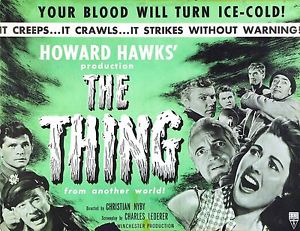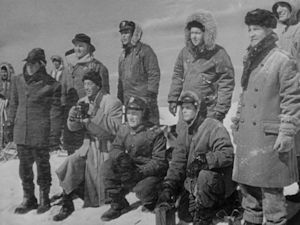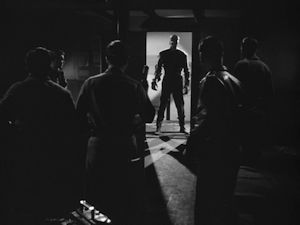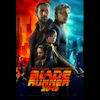The Thing from Another World - Sci-Fi Classic Film Review
Welcome to THINGTOBER! A hostile alien has been revived in a remote Antarctic research station, and we have just one month to deal with it. Starting with John Campbell's classic novella "Who Goes There?" and then carefully dissecting the three films based on its ideas--The Thing from Another World, John Carpenter's The Thing, and 2011's The Thing--we will try to determine what makes this terrifying monster tick and whether or not we can ever be sure it's not right next to us, poised to take over the world.
 | | I seriously can't get enough of these old movie posters |
1951 was a banner year for science-fiction cinema. Definitive films still treasured today, like The Day the Earth Stood Still and When Worlds Collide, were released to near-universal praise and box office success. The one with the highest earnings was The Thing from Another World, produced by the legendary Howard Hawks. A loose adaptation of Campbell's "Who Goes There?," The Thing from Another World is a cut above your average mid-century monster movie, and despite being overshadowed by John Carpenter's The Thing thirty years later, it has managed to hold on to its classic status.
It takes place near the North Pole, where a joint military/scientific outpost witnesses the crash of an alien craft into the ice. Air Force Captain Patrick Hendry and a handful of his men--along with a reporter named Ned Scott--are sent to investigate, and after the craft is accidentally destroyed by thermite, they manage to recover an alien being and bring it back to the outpost. The Thing thaws under the heat of an electric blanket and starts a killing spree, using the blood of man and beast alike to feed and reproduce. The resident scientist, Dr. Carrington, insists that the Thing is peaceful and must not be harmed, but Hendry and his men are determined to stop the bloodshed once and for all.
While it is true the plot barely resembles the novella upon which it was based, The Thing from Another World still owes quite a bit to John W. Campbell. Primary among these is the isolated setting. Despite switching poles, the oppressive loneliness and hostility of the frozen environment still lends a unique tone and atmosphere to the story that exudes anxiety and dread. The characters all have the potential to crack or go stir crazy, and though nobody in the movie loses it the way several characters do in the novella, the undercurrent of psychological horror isn't wholly lost.
 | | It may be in black-and-white, but it's still a colorful cast of characters |
Still, The Thing from Another World is a lighter, more purely entertaining affair. It has fun building tension and suspense, but it doesn't try to get under your skin or unnerve you. Instead, it keeps things from degrading into darkness through witty banter, a quirky romantic subplot, and a few great characters. The Thing itself gets surprisingly little time on screen and the handful of deaths all occur off-camera, which makes this the kind of horror movie that kids could safely watch. (The Hays Code hadn't yet started to erode when this movie came out, so it still adheres to the strict MPAA guidelines of the time.)
Instead of dwelling on the battle with the monster--which this time is a weird vegetable-based creature instead of the telepathic, shape-shifting Thing of Campbell's story--the bulk of the conflict involves the different approaches of Captain Hendry and Dr. Carrington. Hendry is a charismatic figurehead for military decisiveness, while Carrington is a stereotypical mad scientist unfazed by the danger they all face, even after people start dying. Though Carrington isn't totally unsympathetic, it's clear we're supposed to side with Hendry, and this reflects general American attitudes of the time, where science was looked at more skeptically and the military was seen as a more pure force for good.
Make no mistakes, there are plenty of hallmarks of fifties sci-fi cheese to be found. The score is filled with theramins; the scientific exposition is laughably silly; and the monster is a guy in a goofy costume. At the same time, though, the cheese works here in a way it usually doesn't, and this is a movie you can take seriously. Though not directed by Hawks (there are rumors that it was, but I'm not going to get into that), this film feels exactly like a Howard Hawks production, with all that entails. The dialogue, more than anything else, makes it all feel very real and very human, with lively, snappy lines shooting back and forth and reinforcing a sense of well-worn comraderie and warmth. Having Hawks' name and style attached to the film gave it more credibility than your average sci-fi flick of the time, and that's probably what lead to its greater success, both among critics and audiences.
 | | This sequence is incredible |
Then there's the burn scene. At one point, many of our main characters are in a room together when the Geiger counter begins blinking. In this film, the Geiger counter acts kind of like the motion trackers from Aliens in that they alert the crew to the approach of the monster with an increasing frequency of ticks. The men (and woman) quickly decide they'll attack the creature with kerosene and fire, and they turn off the lights as the Thing reaches the door. It crashes into the shadowy room, backlit in the doorway, and then the pails of kerosene are tossed at him and set alight. What follows is a surprisingly lengthy sequence of claustrophobia, panic, and intensity, and it's easily the most memorable and exciting moment in the entire film, a tour de force of choreography, cinematography, and stunt work.
Ultimately, this is a fine example of one of that time period's best sci-fi/horror staples: the creature feature. If you go into it expecting anything like John Carpenter's The Thing or John Campbell's "Who Goes There?," you're bound to be disappointed. But if you go in expecting a thrilling time with quirky characters, a fair amount of cheese, and a few good moments of genuine suspense, you should enjoy it.
-e. magill 10/11/2018
THE UNAPOLOGETIC GEEK'S
THINGTOBER: | |
|
| MORE LIKE THIS: |

|
Blade Runner 2049 - Movie Review
After thirty-five years, is this sequel too-little-too-late, or is Blade Runner 2049 destined to become an important cultural milestone that lives up to its predecessor? [10/12/2017]
|
|
|
|
|